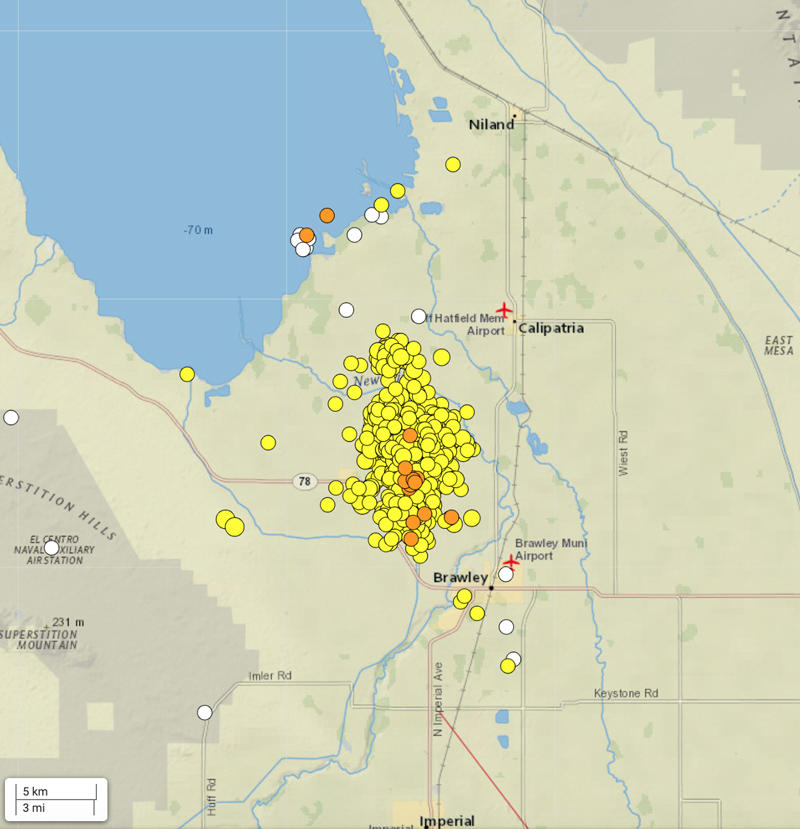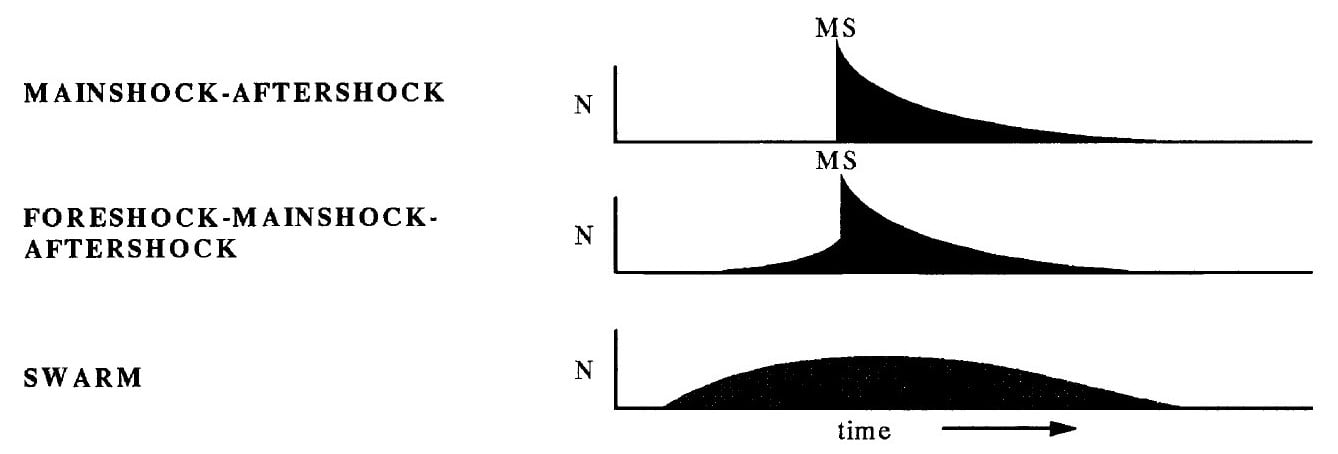More than 100 earthquakes greater than 2.5 in magnitude recently shook Southern California within 24 hours (Figure 1). They occurred from September 30 to October 1, 2020. The strongest was an M4.9 temblor that occurred in the vicinity of Westmorland, near the Salton Sea, an inland desert lake close to the border with Mexico. Shaking was powerful enough to be felt in San Diego and Tijuana but caused no notable damage because the moderate quake’s epicenter was far from exposure at risk. A large group of earthquakes like this is referred to as a swarm, but how is a swarm different from the more familiar sequence of foreshocks, mainshock, and aftershocks?

Foreshocks, Mainshocks, and Aftershocks
Earthquakes are rarely solitary events. The earthquake that makes the headlines is usually the strongest in a series of temblors; it is referred to as the mainshock and is typically followed by a number of aftershocks of diminishing power and frequency over time as the fault that ruptured adjusts to a new equilibrium after the release of accumulated stress.
Most aftershocks follow closely on the heels of the mainshock, but usually the stronger the mainshock the stronger and more prolonged the aftershocks are; they can rumble on for months, years, and even decades. Scientists can forecast the magnitudes and rates of earthquakes in an aftershock sequence with some precision. The first and strongest aftershock is often one magnitude below the mainshock, for example.
Sometimes mainshocks are presaged by a series of foreshocks of increasing intensity; foreshocks are typically identified, along with the larger mainshock and weakening aftershocks, after the full sequence is complete. Sometimes it can take months to identify the sequence, as was the case with the 2010–2011 Canterbury Earthquake Sequence, comprising the September 2010 M 7.0 Darfield earthquake and its major aftershock, the February 2011 M6.2 Christchurch earthquake, and the Landers Sequence.
Swarms
Earthquake swarms are different. They are normally fairly brief events consisting of a large number of modest temblors with no identifiable mainshock (Figure 2). Swarms may last for a few hours or a few months, and don’t behave as predictably as aftershock sequences—they can intensify after slowing down, for example.

Swarms are often, but not always, associated with volcanic or geothermal activity and can recur in the same locations. Magma moving to the surface prior to volcanic activity can trigger them, as it did in the weeks before the eruption of Mount St. Helens in 1980, for example, and in Yellowstone—known for its geothermal activity—swarms are common. According to the USGS one of the largest and longest swarms there was the 2017 Maple Creek Sequence, which lasted for about three months and consisted of about 2,400 recorded earthquakes.
Swarms can also be caused by tectonic activity, as seen in recent swarms in the Western U.S. attributed by the USGS to “extension of the western USA—the same force that caused the recent (2020) main shocks in Utah and Idaho.” What the USGS described as “the most energetic and persistent earthquake sequence in Nevada’s recorded history” occurred from 2014 to 2018, for example, and another large swarm struck Montana from late 2018 to early 2020.
The Swarm in California
The recent swarm in California occurred in the Brawley seismic zone—a linear zone of seismicity (up to 10 km wide) between the San Andreas and Imperial faults. It is a complex region overlying an inferred spreading region with an assortment of faulting types associated with this seismic zone. Earthquake swarms are common in this area. In 1981 a swarm in the same Westmorland area, for example, included an M5.8 earthquake; more than 300 temblors (including a M5.4) shook the region in the 2012 Brawley Swarm; and another sizeable swarm of 250+ temblors occurred south of the Salton Sea in 2017. In September 2016 the Bombay Beach Swarm led to a week-long earthquake advisory because of an increased probability of a >M7.0 earthquake occurring along the San Andreas Fault. The Bombay Beach Swarm occurred only about 28 miles northwest of the 2017 swarm and roughly 12 miles north of last week’s Westmorland Swarm.
Although the high number of earthquakes in the recent Westmorland Swarm was alarming, they were modest in magnitude and did not present a risk to life or property. According to the USGS forecast for the swarm, while the probability of a >M7.0 earthquake occurring during a swarm in this area is “significantly greater” than usual, it is still only about 1 in 2,500.
Reliably assess and manage seismic risk with AIR earthquake models




